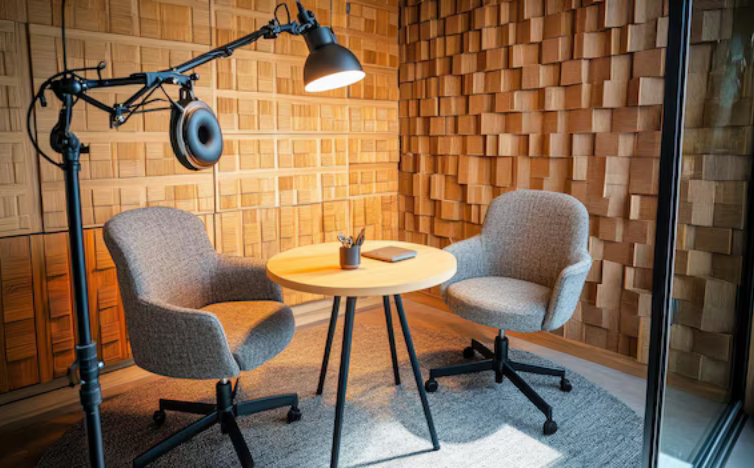Creating a soundproofed podcast studio is essential for achieving crisp, professional-quality audio that listeners appreciate. Background noises, echoes, and external disturbances can detract from your sound quality, making it crucial to invest in effective soundproofing. Here’s a guide to the best soundproofing tips for your podcast studio.
Tips for Acoustic Podcast Studio

1. Identify Sound Sources and Problem Areas
Before starting the soundproofing process, identify where noise is entering or echoing in the studio space. Common sound sources include external traffic noise, vibrations from neighboring rooms, and indoor reverberations. Once these are pinpointed, you’ll have a clearer idea of which areas to target for optimal soundproofing.
2. Seal Doors and Windows Properly
Doors and windows are the primary entry points for external noise. Consider these methods for reducing sound transmission:
- Install Weather Stripping: Use weather stripping or acoustic door seals to close gaps around the door frame, preventing sound leaks.
- Acoustic Door Sweeps: Door sweeps can seal the gap at the bottom, blocking additional noise.
- Soundproof Curtains: For windows, consider heavy-duty soundproof curtains that help absorb and dampen incoming sounds effectively.
3. Add Acoustic Panels for Wall Sound Absorption
Acoustic panels are essential for managing internal reflections and preventing echoes. Here’s how to make the most of them:
- Strategic Placement: Place acoustic panels on walls closest to where you speak and on opposite walls to absorb direct sound reflections.
- Variety of Panel Sizes: Use different panel sizes and shapes to cover more surface area and balance sound absorption throughout the room.
- Fabric-Wrapped Panels: These can be customized to match the studio’s decor while effectively managing sound reflection and reducing echo.
4. Use Bass Traps in Corners
Low-frequency sounds often build up in the corners of a room, causing a “boomy” sound in recordings. Bass traps are designed to absorb these lower frequencies effectively:
- Corner Placement: Install bass traps in each corner of the room to balance out low-frequency waves.
- Size and Density: Opt for thicker, denser bass traps to capture and reduce excess bass in your audio.
See Also: Enhancing Podcast Audio with Acoustic Panels in the Studio
5. Install Soundproofing for Floors
Floors can also contribute to unwanted noise through vibrations or echoes. Soundproofing them adds an extra layer of acoustic insulation:
- Carpeting or Area Rugs: Soft materials like thick carpets or rugs absorb sound and reduce floor reflections.
- Floor Underlays: Acoustic underlays are another option for further reducing sound transmission through floors, especially if your studio is above a busy area.
6. Use Soundproof Ceiling Solutions
Ceiling soundproofing helps reduce noise from overhead sources and enhances the overall acoustic quality of the room:
- Acoustic Ceiling Tiles: Install sound-absorbing ceiling tiles to reduce sound reflection in the room and prevent external noise from entering.
- Ceiling Clouds or Baffles: These are additional acoustic treatments that can hang from the ceiling, capturing sound and preventing it from bouncing off hard surfaces.
7. Minimize Background Noise with Soft Furnishings
Soft furnishings can play a huge role in deadening sound within a studio. Consider adding:
- Furniture with Fabric Covers: Upholstered chairs or sofas absorb sound, making them excellent additions to a podcast studio.
- Thick Curtains or Tapestries: If your walls have windows or are bare, hang thick curtains or fabric tapestries to reduce sound reflection and add a cozy feel.
8. Use Mass Loaded Vinyl for Extra Wall Insulation
For studios with high levels of external noise, Mass Loaded Vinyl (MLV) is an ideal solution:
- Install on Walls: MLV is dense, flexible, and highly effective for blocking sound from entering through walls.
- Easy Installation: It can be layered under drywall or between wall panels to enhance sound insulation without a significant remodeling effort.
9. Create a DIY Soundproof Booth for Portable Isolation
If a permanent setup isn’t possible, consider setting up a small, portable soundproof booth:
- Booth Kit or DIY Options: Purchase a pre-made soundproof booth or use thick blankets, foam panels, and PVC pipes to create a temporary enclosure.
- Perfect for Consistency: This helps maintain audio quality and consistency across episodes, even if you record in various locations.
See Also: The Importance of Acoustic Treatment in Podcast Studios
10. Invest in Quality Soundproofing Materials
Investing in high-quality materials for soundproofing yields better results over time:
- Acoustic Foam and Panels: High-density foam and professional-grade acoustic panels offer superior sound absorption.
- Durable Sealing Materials: Durable weatherstripping, door sweeps, and MLV ensure lasting soundproofing that won’t deteriorate quickly.
Call us: Contact DeSound Soundproofing Expert in Dubai For Soundproofing: +971 56 231 4204
By incorporating these soundproofing tips into your podcast studio setup, you can create an acoustic environment that brings out the best in your recordings. A soundproofed space will help you achieve professional sound quality, keeping your audience engaged and your content free from distracting background noise.

